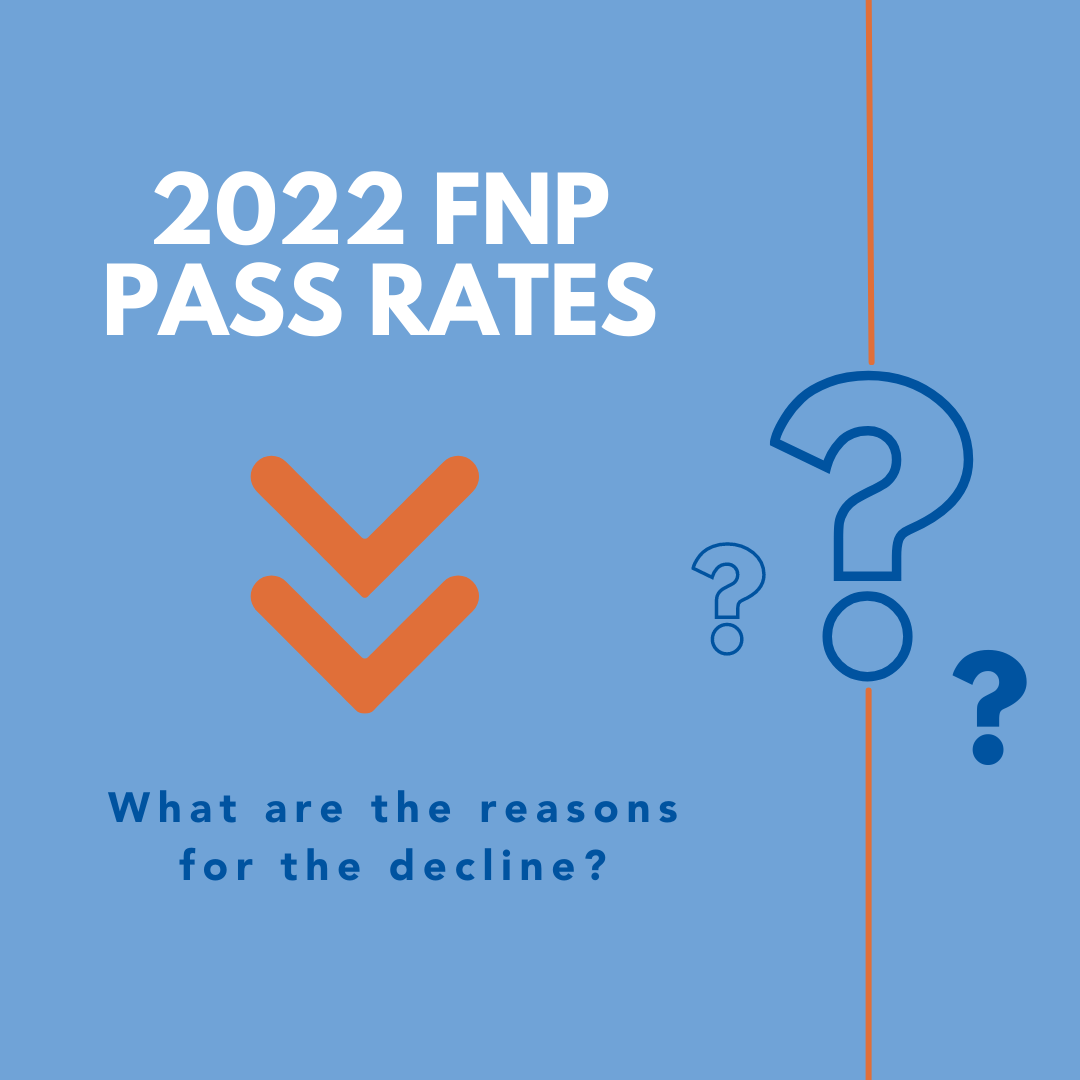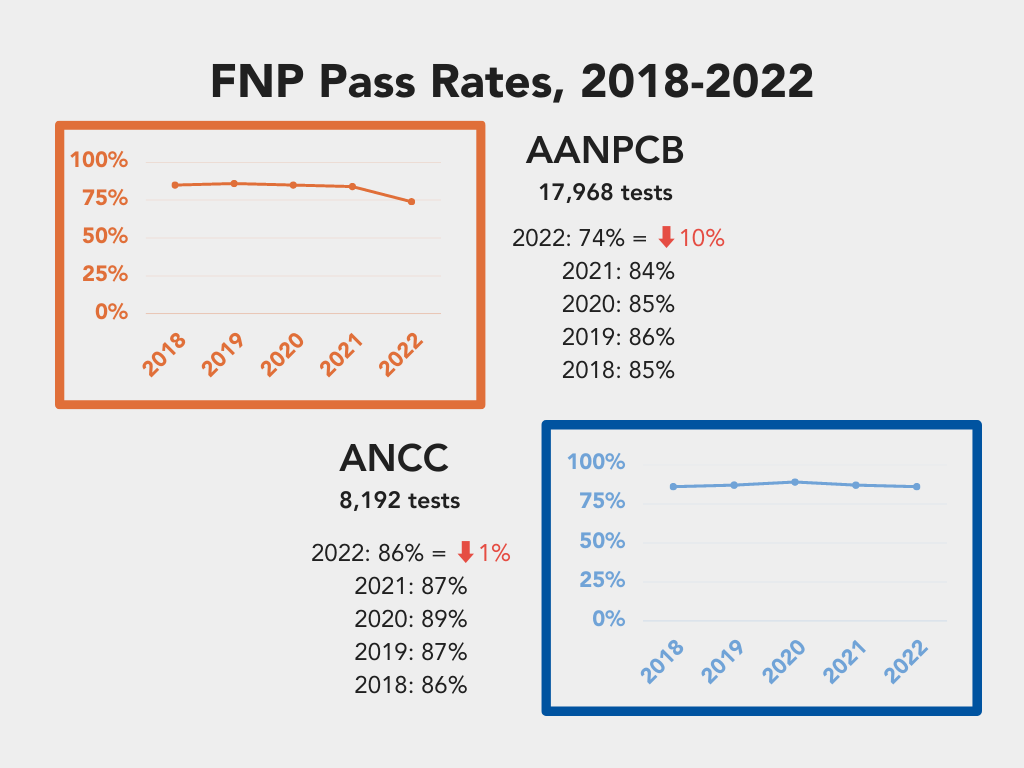Why did family nurse practitioner pass rates decline?
- Sept. 1, 2023
Share:

Contributing factors include pivoting curriculum delivery and pandemic-related trauma
Certification data for 2022 show that pass rates for family nurse practitioner candidates dropped by 10% on one of the two available exams — the most significant decline in the history of this certification.
Pass rates for the FNP exam from the American Association of Nurse Practitioners Certification Board (AANPCB) were 74% in 2022, down from 84% the prior year. This exam is the entry point for the majority of FNPs: 68% of FNP candidates took the AANPCB exam in 2022. The other available FNP exam, from the American Nurses Credentialing Center (ANCC), recorded a 1% decline in pass rates, dipping from 87% to 86%.
What factors led to the significant decline in pass rates? What do the 2022 rates suggest about NP preparedness overall? And what should FNP students and faculty do now to achieve better outcomes in 2023 and beyond? We talked with two educators and a university and faculty consultant who collectively have focused on NP preparation for more than 20 years. Each of these experts emphasized that the 2022 exam results should not cause alarm. They should, however, prompt introspection and action.

Rippling impacts of the pandemic on FNP pass rates
Most students who graduated from an NP program in 2022 were not very far into their academic programs when the nation essentially shut down in March 2020. NP programs with ground campuses or hybrid models were forced to immediately rethink how they would provide education. Clinical sites became unavailable, creating a first-of-its-kind deficit in an essential part of NP preparation.
“Educational programs had to pivot to deliver content online, and students had to find new preceptor sites or delay graduation because there were no sites available,” said Kathy Baldridge, DNP, FNP-BC, FAANP, lead Nurse Practitioner Education Specialist for Advanced Practice Education Associates (APEA), an ATI brand. “Most were still working as RNs in the hospital and experienced high rates of stress and burnout. I believe this contributed greatly to the decline in pass rates.”
Lindsey Luther, DNP, APRN, FNP-C, CNE, EBP(CH), was the lead faculty member for the FNP program at Mt. Carmel College of Nursing in 2020. She is now a Nurse Practitioner Education Specialist for APEA. “The COVID-19 pandemic was a collective trauma for all of us,” Dr. Luther said. “We all worried about the health of loved ones, the ability to stay financially solvent despite work disruption, and the impact on society at large.
“As practicing RNs, NP students experienced additional vicarious traumas as they faced the human cost of the pandemic on their patients,” she continued. “Neuroscience tells us that it is impossible to learn when in a state of threat because the prefrontal cortex goes offline.”
At the height of the pandemic, many of Dr. Luther’s FNP students were either out of work due to department closures or working an extra 12 to 24 hours per week to meet hospital demand. In addition, most were caring for dependent children or elders.
“So yes, these students changed their study habits during the pandemic. But this wasn’t necessarily a choice,” she said. “Unfortunately, once the pandemic started to settle, students were already far behind in their foundational preparation and application of knowledge. They needed more guided instruction in the foundational skills that support their practice, and this is why I feel called to help prepare these NPs for their career.”
Online education, proctor-free testing influenced NP student performance
For many NP programs, the rapid pivot to 100% virtually delivered education was a challenge. Academic programs have made vast improvements in online curriculum delivery since then, but faculty and students faced a steep learning curve in 2020 and 2021. These were foundational periods for the graduates of 2022. All three APEA experts noted that the curricula content provided between 2020 and 2022 had not changed; the circumstances of delivery had.
“Overall, I believe the biggest impact was pivoting from in-person learning to online learning. Students have different learning styles and have traditionally been able to choose their method of learning,” Dr. Baldridge said. “If you look at the pass rates for the years prior to 2022, they have been consistent since 2018. That eliminates current education and resources as being impactful in the decline and brings it back to individual student study habits.”
Another adjustment made by some NP programs was the delivery of exams without the safeguard of proctoring. Testing at home created situations in which it became easier to look up answers or consult friends for guidance. This resulted in test scores that might not have accurately reflected knowledge.
“Allowing students to take exams without proctoring during the COVID-19 pandemic likely had an impact on student confidence levels,” said Betty Vicknair, MSN, APRN, PNP, a curriculum and remediation expert who has worked with NP programs for almost a decade. Vicknair is an integration specialist for APEA. “If a student took a competency exam or other meaningful assessment and used inappropriate methods to achieve the passing score, this gave them a false sense of security. They thought they were prepared and would be successful on the certification exam. As indicated by the data, many of them were not.”
Recommendations for students
FNP students preparing for certification in 2023 and 2024 are likely wondering more about the steps they should take to ensure success than dissecting the reasons for the drop in AANPCB pass rates in 2022. But the wise student will learn from history.
“I think students should see this drop in pass rates as data that informs their strategy,” Dr. Luther said. “Knowing that recent NP graduates were not as ready as in the past, current students should reach out for additional help.
“I find that most new NP graduates have an understanding of their own weaknesses. However, they are unsure how to address these weaknesses, and so they avoid them,” she continued. “As you prepare for your certification, you need to constantly assess what you do and don’t understand, then seek out help or resources to address those knowledge deficits. As a future NP, you will have to learn new knowledge every time the science changes! So, get into the habit of asking yourself, ‘what don’t I know about this?’ and then pushing yourself to learn more.”
Dr. Baldridge points to the 2022 rates as an opportunity for reflection. The dramatic drop in FNP pass rates should cause students to honestly evaluate their decision to become a nurse practitioner and to make a course correct if needed.
“Students should take the decline in pass rates personally, and it begins with why you want to become an NP,” she said. “Think seriously about why you are choosing this profession. If you are just tired of the bedside, that isn’t a good reason. If this is the right path for you, then the second step is to choose a university based on the program’s pass rates, not the ‘fastest’ or ‘easiest’ way to get your degree. Then, throughout the program, continue to take it seriously. Put in the work and dedication it takes to gain the knowledge needed. We have seen and heard of far too many instances of cheating. When you get to the certification exam, there will be only you to determine whether you have the knowledge necessary to become a board-certified NP. Take it personally and take it seriously.”
Recommendations for faculty and academic programs
In terms of faculty and program actions based on 2022 FNP pass rates, APEA's education experts recommend careful evaluation of incoming students to assess preparedness, curriculum emphasis on pathophysiology pharmacology, and physical assessment knowledge (the 3Ps), and placing faculty in closer alignment with expertise.
“A house is only as strong as its foundation, and the 3Ps are the foundation of advanced practice,” Dr. Baldridge said. “There also should be a variety of assessments to determine student competency levels, including summative and authentic assessments to determine mastery. I believe when the right people are admitted and the 3P foundation is firm, we will see improvements in pass rates.”
Optimum utilization and placement of faculty will also have a positive impact. “Placing faculty in appropriate positions aligned with their expertise will improve students’ ability to grasp the content and concepts, so that they can achieve learning outcomes and program objectives,” Vicknair said. “In addition, faculty need to constantly look at their curricula and revise as needed based on outcomes. The analysis of aggregate data from assessment results helps determine knowledge gaps that need to be addressed.”
Vicknair recommends seeking vendors who develop resources that are valid, reliable, and proven to achieve desired program outcomes, and who provide documentation to support these statements. She also recommends that faculty and preceptors challenge students more often, making them accountable and responsible for their own learning.
“Offer them resources that enhance didactic instruction to build on that 3P foundation,” she said. “Focus on remediation after each assessment and assist students in creating study plans to close the knowledge gaps identified in these assessments.”
To better prepare students for certification, Vicknair recommends providing resources that align with exam blueprints and directing students to resources that focus on content and concepts they will encounter on the exam.
“Placing curriculum resources such as study questions with rationales and online review courses is a proactive approach to learning and it increases critical thinking and clinical reasoning,” Vicknair said. “With this support, students are better able to make competent decisions. This also increases their self-confidence because they are exposed to content that is similar to what they will see on the certification exams.”
Dr. Luther, whose academic experience includes serving as a faculty mentor, commented that the effective development of nursing faculty benefits from time, guidance and resources.
“Developing good students begins with developing strong faculty who are able to apply solid pedagogical strategies to effectively communicate their nursing expertise to students,” she said. “The great news is that there are so many high-quality educational products available to support NP faculty as they grow these skills. For example, APEA products utilize evidence-based pedagogical strategies to communicate difficult concepts to students in a way that they can understand and remember. I would encourage faculty to explore these products and how they can bolster their curriculum. One opportunity I can see is early implementation of a review course into the curriculum as a preparatory program for clinical courses and/or as a teaching aid alongside the current practical courses.”
For information on APEA curriculum and faculty resources for nurse practitioner education programs, visit the Faculty Resource Center or email requestinfo@apea.com.
Certification Data Sources
AANPCB pass rates: American Association of Nurse Practitioners Certification Board. Annual reports. https://www.aanpcert.org/certs/pass
ANCC pass rates. American Nurses Credentialing Center. 2022 ANCC certification data. https://www.nursingworld.org/~497c80/globalassets/docs/ancc/ancc-cert-data-website.pdf
Study and Curriculum Resources
3P Study Questions. APEA MyQBank Pathophysiology, Pharmacology, and Assessment
Predictive exams to determine readiness for testing and to guide study plans. APEA Predictor Exams
Certification review courses. APEA On-demand courses and live courses